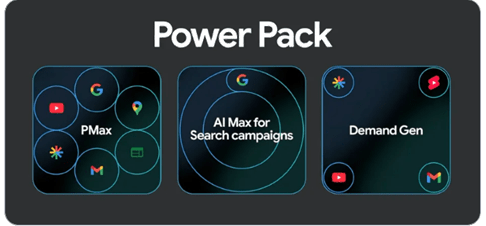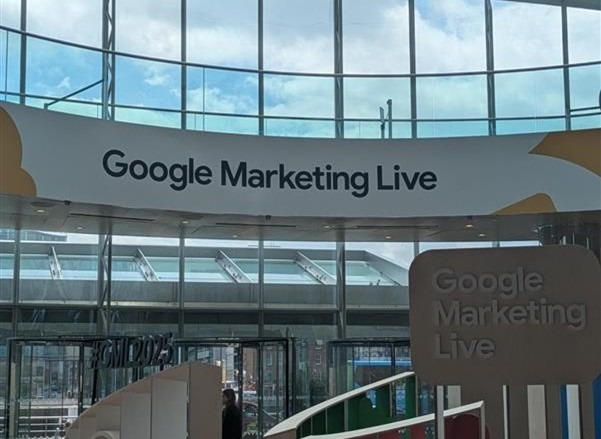Rounding Up Google Marketing Live 2025
KINESSO's highlights from Google Marketing Live 2025 - AI-driven search, campaign insights, creative tools, and YouTube creator partnerships reshape advertising.
Authored by Tom Clough | 23rd May 2025Google Marketing Live 2025 took place this week, showcasing all the latest and greatest upcoming features across Google’s advertising platforms.
AI, as expected, took centre stage again this year (and arguably most of left stage and right stage too!), with a host of announcements around how Google’s tech will integrate AI deeper into campaign deployment and user experiences – helping marketers to develop sophisticated campaigns in record time while giving users new and immersive search experiences.
So, which of the announcements are we at KINESSO most excited and intrigued about? What do you need to be keeping top of mind in the world of AI Search? And can I get through this blog post saying “AI” less than 20 times? Let’s dive in.
The pMax “Black Box” is becoming more transparent
Since the initial launch of pMax back in Nov 2021 (yes, it’s been nearly 4 years!), there’s been demand from advertisers for Google to continue feeding more data on campaign performance, and which specific campaign elements are driving performance. GML 2025 announced key advancements in this space, with Google opening up further visibility on the search terms your pMax campaigns are appearing against and channel-level reporting functions within ad platforms.
This is a major boost for advertisers to see how each channel is directly impacting on the conversions that pMax is delivering. These new insights will help advertisers to analyse and optimise existing campaigns and take learnings into new campaign setups for better, long-term performance.
The AI Search Experience has landed
Ads are rolling out further across Google’s AI-powered responses, AI Overviews & AI Mode. Previously only tested across AI Overviews on Mobile within the US, and limited to Shopping placements, ads will now be expanded across AI Overviews on desktop, and begin to be integrated into the new AI-Mode platform (Google’s LLM Search platform, which has been available within Google Labs in the new US, but is now rolling out across the market).
This is a huge shift for the search industry, and arguably the announcement that shows clearest where the future of search is heading. Conversational search queries with complex questions have the ability to cut a user’s path from information to purchase down immensely, reducing the research phase to a couple of detailed questions, answered through AI generation and contextual ad selection.
Advertisers who remain solely focussed on specific keyword sets and capturing lower-funnel search demand may find themselves out of the conversation entirely if they don’t adapt once volumes of LLM searches increase. Brands should start thinking today about how they can future-proof activity and adapt to these advancements.
AI Max For Search & The ‘Power Pack’
GML2024 saw the emergence of the “Power Pair”, a combination of Performance Max & AI-powered search campaigns to drive optimal performance. In 2025, this has been upgraded to the “Power Pack” which now combines Pmax, AI Max For Search and Demand Gen as “the next generation of AI-powered campaign solutions” (Google’s words).
The integration and search and other Google Platforms, especially YouTube, was a key focus of GML2025, and the Power Pack is the new, fully AI-integrated model of driving cross-channel success.

The newest of the pack is AI Max For Search, a campaign setting which effectively incorporates the AI-driven search targeting elements of DSA, Broad Match and pMax into a single place to provide incremental reach to high performing queries and drive greater user engagement.
Advertisers can select whether they want to target search terms based on Asset Optimisation (AI takes text from your existing ads, assets and landing page to tailor ad copy closer to user searches in real time), for Search Term Matching (AI derives context from your assets, keywords and landing pages to target new search term queries), or for both to simultaneously run AI boosted ads to AI-selected search terms. For full clarity: AI Max is not a new campaign type, but rather a setting to be enabled on existing search campaigns.
Google Ads Connects Brands to YouTube Creators Directly
A clear focus of GML2025 was proving the quality of engagement, both direct and attributed, that is being driven through YouTube. This is especially true of short-form and long-form Creator content. Google has been reinforcing its position as a key platform, with the added bonus of being able to directly connect the activity advertisers are driving on YouTube into the rest of their marketing across Google Platforms.
The “Creator Partnerships Hub” is a new, central place to manage creator partnerships, which sits directly within Google Ads. The Hub will allow brands to search for relevant creators and begin outreach, as well as discover a bank of existing sponsored videos that mention their brand.
Brands have long understood how the right creator partnership can help build trust within new and existing audiences, and Google is making it easier to both define and find that “right creator”.
Demand Gen as a campaign type (where visual and video creative are essential) certainly had a spotlight at GML2025, and tools like these will help to enhance the ways advertisers gather the creative to fuel Demand Gen and optimise their performance.
Go Shopping With AI
AI is about to enhance the user experience within shopping ads in big ways – think having your own personal shopper and virtual dressing room sitting within your device.
New agentic experiences across Shopping will help the users through new product discovery and product refinement, whether you’re just in the market for a new sofa and want some inspiration, or whether you already have a pretty set idea of what your dream couch will look like and want to find products that fit the bill.
Conversations with the AI agent will help to narrow down product selection, while AI Mode will also incorporate a ‘price tracking’ feature: once you’ve found your perfect item, set your ideal buy price and the AI agent will notify you if it detects a drop – you can then confirm purchase and the AI will link to your Google Wallet to complete the purchase. Seamless stuff!
If you’re looking for more fashion than furniture, Google has that covered too, with new ‘try it on’ features overlaying items onto your pictures so you can see how it will look – this one is probably more impressive to actually see in action, so take a look here.
AI Creative Advancements
Last on my list are the AI Generated Creative solutions that continue to get much more sophisticated at a truly baffling rate. Combining the power of generative video and static creation, through Veo 3 or Imagen 2, and AI-assisted editing capabilities in Power Studio, the control and generation of high quality, brand-safe assets in record time is truly in advertisers’ hands.
I was particularly impressed by the AI Out-Painting capabilities to re-size creatives – the black boxes that go around a square video on mobile will soon be a thing of the past (for a nice example of this in action, see how Google has used this tech to out-paint the Wizard Of Oz to fit on the Las Vegas Sphere screen).
Final Thoughts
AI is no longer an optional extra to enhance campaigns across Google platforms, it’s an absolutely crucial integration to streamline every part of the process across creation, delivery, optimisation and analysis, all while removing friction points for the user to make search as effortless as possible.
GML2025 is a good point to take a step back and review just how far these capabilities and platforms have evolved since just 12 months and consider just how the landscape might look when we land at GML2026 – very exciting (and very busy!) times ahead!
P.s for anyone keeping count, there’s 27 ‘AI’s’ in here. Well, now 28….
